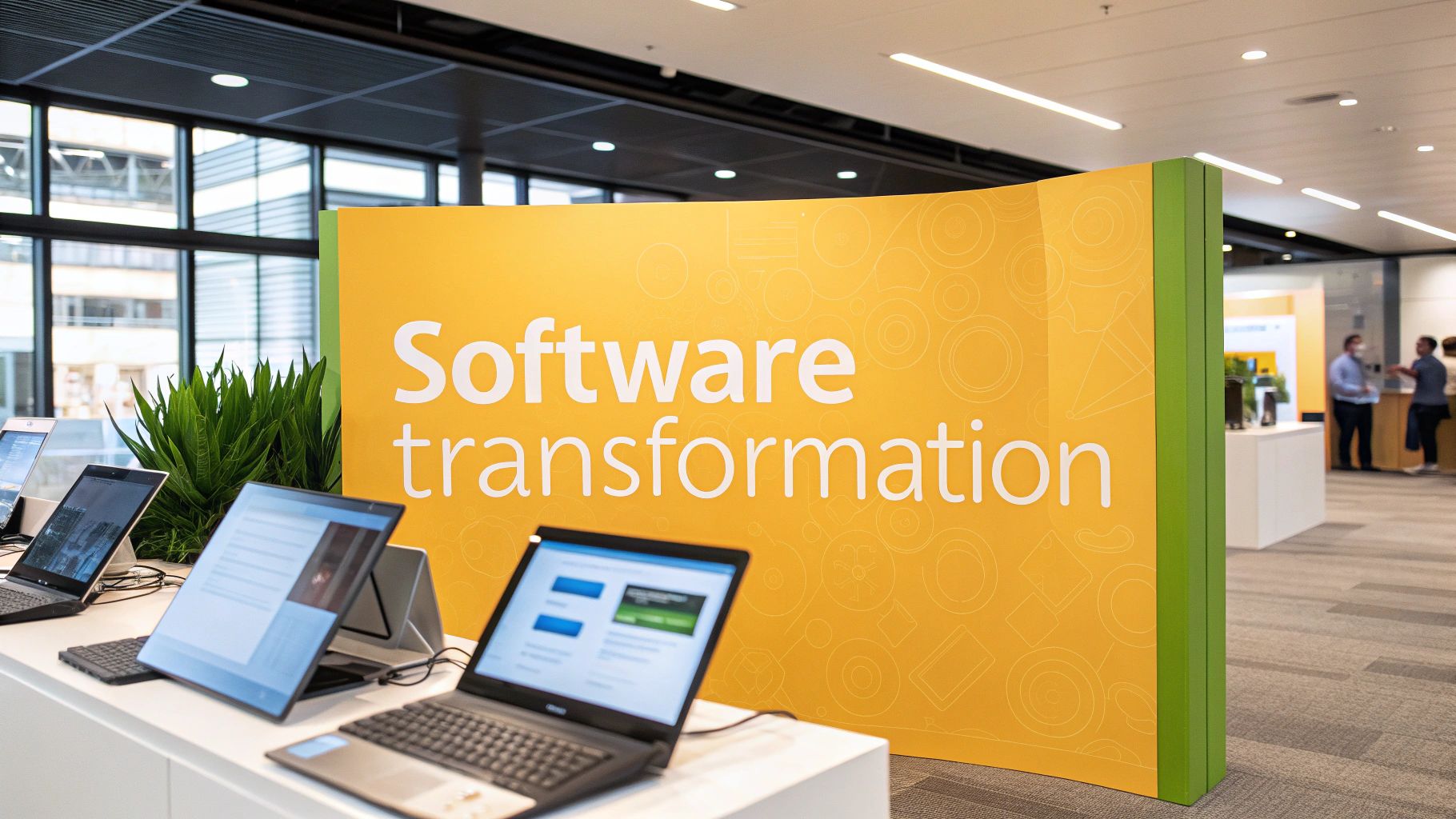From our resource library for organizational scheduling and management.
The Ultimate Guide to Management Software Services: Transform Your Business Operations

Understanding Modern Management Software Services

Management software has come a long way from simple task trackers. These tools now power core business operations, helping companies work smarter and get better results. The right software makes a real difference in how teams collaborate and how businesses compete.
The Evolution of Management Software
In the past, companies used separate tools for different tasks like scheduling and project tracking. Now, management software brings everything together in one place. Modern platforms handle customer relationship management (CRM), human resources (HR), and enterprise resource planning (ERP). This gives managers a clear view of their whole operation and helps them make smart choices based on real data.
The Impact of Cloud Technology
Cloud computing has changed everything about how we use management software. Cloud-based tools can grow with your business and work from anywhere. They often cost less to run than traditional software, which means even small companies can use powerful management tools. This has opened up new possibilities for businesses of all sizes.
The Growing Market for Management Software Services
More companies are investing in management software than ever before. The global market reached $594.53 billion in 2024 and experts predict it will grow to $1,833.36 billion by 2034. That's an impressive 11.92% growth rate from 2025 to 2034. This growth comes from more companies working together, better technology, and new AI tools that make work easier. Find more market data here: Business Software Market Research
Key Benefits of Modern Management Software
Good management software makes organizations work better in several ways:
- Improved Collaboration: Teams share information and work together easily
- Enhanced Productivity: Automatic features handle routine tasks so people can focus on important work
- Data-Driven Insights: Real numbers help leaders make better decisions
- Increased Efficiency: Better processes save time and resources
- Greater Scalability: Cloud software grows with your business
These improvements have made business management clearer and more effective. Next, we'll look at which features matter most for business success.
Essential Features That Drive Business Value

Selecting business management software comes down to identifying the features that matter most for your organization's success. The right tools go beyond basic organization to help teams work smarter and get real results. Let's look at the key features that make a meaningful difference.
Project Management Powerhouse
Good project management forms the foundation of business success. The best software provides clear tools for planning and tracking work from start to finish. Key features to look for include Gantt charts for timeline planning, Kanban boards for task tracking, and dependency management to keep projects flowing smoothly. Equally important are team tools like shared calendars, document storage, and easy communication options that keep everyone in sync.
Resource Optimization and Allocation
Smart resource management helps teams make the most of their people, budgets and equipment. The right software makes it simple to match the best people with priority tasks at the optimal times. This helps prevent bottlenecks and keeps projects moving forward efficiently. Want to improve your team scheduling? Check out: How to master staff scheduling.
Workflow Automation for Streamlined Operations
Reducing manual work frees up time for higher-value activities. Good management software can handle repetitive tasks like approvals, notifications, and data entry automatically. For example, automated invoicing and payment reminders help improve cash flow while reducing administrative work.
Integration and Customization: Key Considerations
Your management software should work smoothly with your existing tools to keep information flowing. Look for options that connect with your CRM and other core business systems. The ability to customize features for your specific needs is also essential, especially if you have unique processes or industry requirements.
The business software market continues to grow, powered by advances in AI and cloud technology. Current estimates value the market at USD 468.51 billion, with projected growth of 10% annually from 2025-2034 as more companies adopt cloud and automation tools. For more details, see the Business Software and Services Market report. The right software choice helps organizations improve efficiency and results in meaningful ways.
Proven Implementation Strategies for Success

Rolling out new management software doesn't have to be overwhelming. With good planning and a clear roadmap, companies can make the transition smoothly and get the most value from their investment. Let's look at what makes implementations successful.
Key Phases of Implementation
The implementation process works best when broken into three main stages: assessment, selection, and deployment. Start by taking a close look at how your organization operates today and what it needs. This groundwork helps you pick software that's the right fit. Research different options carefully and choose one that matches both your needs and budget. Finally, install and set up the software, then roll it out to your teams.
Building Effective Change Management Strategies
Getting people on board is crucial for success. Be upfront about how the new software will make work easier and better for everyone. Give teams the training they need to use it confidently. Set up a help desk or support team that can quickly answer questions and fix problems. When people feel supported, they're more likely to embrace the change.
Securing Genuine User Adoption
For software to deliver real value, people need to actually use it. Beyond just training, create excitement around the new tools. Highlight team members who are using it well - their success can inspire others. Listen to feedback and make improvements based on what users tell you. Want more workforce management tips? Check out our guide on staff roster programs.
Maintaining Momentum Throughout the Transformation
Implementation isn't a one-and-done project - it needs ongoing attention. Keep track of key metrics to see how the software impacts your business results. Check in regularly with users to spot and fix any issues. Stay flexible and adjust your approach as needed. This helps ensure the software keeps delivering value as your business grows and changes.
Practical Frameworks for Different Organizations
Every organization needs an implementation approach that fits its size and industry. A small business might roll out software all at once, while bigger companies often do it in phases. What works for a retail business might not work for healthcare. The key is being flexible and adapting the process to your specific needs.
Pitfalls to Avoid
Watch out for common mistakes that can derail your implementation. Poor planning, skimping on training, and weak communication often cause problems. If you ignore user concerns or skip regular maintenance, people may stop using the software. Plan ahead for these challenges to keep your implementation on track and successful.
Maximizing ROI Through Strategic Optimization

Getting management software is just the start. The real value comes from smart optimization that improves your return on investment (ROI). This means measuring what matters, fine-tuning your processes, and making decisions based on data rather than guesswork.
Identifying Key Performance Indicators (KPIs)
Start by choosing metrics that show how your management software is helping your business. Your Key Performance Indicators (KPIs) should match your goals. If you want faster project delivery, track how quickly projects get done. For better customer service, look at satisfaction scores and response times.
Optimization Techniques for Management Software Services
After picking your KPIs, focus on making improvements. This could mean simplifying workflows, setting up automation for routine tasks, or finding better ways for teams to communicate through the software. When teams spend less time pushing paper, they can focus on work that matters. Good reporting tools help spot where things could work better.
Continuous Improvement and Data-Driven Decision Making
Getting the most from your software takes ongoing effort. Check your numbers regularly and adjust when needed. If projects start taking longer to complete, find out why and fix the problem. Keep fine-tuning as your business grows and changes. You might find this helpful: How to master employee scheduling.
Real-World Examples of ROI Transformation
Many companies have seen big gains by using their management software well. A factory cut mistakes by 20% by managing resources better. A store boosted sales 15% with smarter inventory tracking. These stories show what's possible when you use these tools effectively.
Building a Culture of Data-Driven Decision Making
Create an environment where people look at data before making choices. Help your team use software reports to spot patterns and solve problems. When everyone from entry-level staff to executives uses data this way, good ideas can come from anywhere. Each improvement leads to new insights, creating an ongoing cycle of positive change.
New Directions in Management Software Services
The field of management software continues to change at a rapid pace. Understanding these changes helps businesses make smart choices about their software tools and stay competitive. Here's what's shaping the future of business software and how companies can adapt.
AI Takes Center Stage
Artificial intelligence is reshaping how businesses use management software. Modern AI tools can handle routine work, process large datasets, and spot trends humans might miss. For managers, this means better decision-making backed by solid data. A good example is smart scheduling - AI can create work schedules that save money while keeping enough staff on hand during busy times.
How Machine Learning Makes Software Smarter
Machine learning helps management software get better over time by learning from experience. As the software processes more data, it makes more accurate predictions and gives better advice. This turns your software from a basic tool into something that actively helps improve your business. ML systems are especially good at finding hidden patterns in your business data - like customer buying habits or market shifts.
Blockchain's Promise of Better Security
Blockchain technology is starting to appear in management software, offering new ways to keep data safe and trackable. By creating records that can't be changed or deleted, blockchain helps ensure data stays accurate and trustworthy. This matters most for businesses that need to follow strict rules, like banks or healthcare companies. When managers can trust their data completely, they make better choices.
Making Better Decisions with Advanced Analytics
Today's management software includes powerful analytics tools that help businesses use their data effectively. These tools process complex information and show real-time updates on important metrics. This helps companies spot problems quickly and adjust their plans as needed. Think of analytics dashboards that show sales numbers, marketing results, and customer retention rates all in one place.
Getting Ready for What's Next
To make the most of these new developments, companies should:
- Check New Tech Carefully: Make sure any new technology actually fits your business needs
- Train Your Team Well: Help employees learn how to use new software tools effectively
- Welcome Change: Create a workplace where trying new things is encouraged
Companies that understand and use these new tools wisely will be better prepared for future changes in management software.
Essential Best Practices for Long-Term Success
Making the most of your management software requires ongoing commitment and attention. Learn how successful organizations build and maintain effective software systems that deliver value year after year.
Empower Your Team Through Comprehensive Training
Getting your team fully trained on your management software is key to seeing real results. Regular training sessions help staff master both basic functions and advanced features as they're released. Consider running monthly workshops or sharing video tutorials to keep skills fresh. When team members truly understand the tools at their disposal, they work more efficiently and get more done.
Prioritize Security to Protect Your Investment
Strong security measures are essential for protecting sensitive data in your management system. Regular security checks and updates help catch potential issues early. Think of it like maintaining your car - addressing small problems prevents major breakdowns later. Be sure to implement strong password requirements and two-factor authentication to keep unauthorized users out of your system.
Implement Ongoing Maintenance for Peak Performance
Your management software needs regular care to run at its best. This includes keeping the software updated, backing up data regularly, and monitoring system health. Regular backups provide crucial protection against data loss. Having your IT team actively monitor performance helps catch potential problems before they affect users.
Embrace Continuous Improvement for Long-Term Value
The most successful organizations treat software optimization as an ongoing journey. Take time to evaluate how your team uses the software, identify bottlenecks, and adjust processes as your business grows. Look for opportunities to automate manual tasks and integrate helpful new features. By treating your software as a tool that grows with your company, you'll continue seeing strong returns on your investment year after year.
Ready to improve your workforce management with scheduling software that just works? See how Acroroster can help streamline your scheduling, boost team communication, and make your staff more productive. Learn more about Acroroster and request a demo.